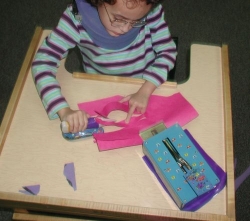Designers: Travis McLeod, Andrew Reish
Client Coordinators: Robbin Newton, Lenox Baker Hospital
Supervising Professor: Dr. Larry N. Bohs
 The goal of this project was to design a device to allow our five-year-old client, who has cerebral palsy, to safely and independently cut paper. To meet this need, we designed a paper holding fixture and a pair of electric scissors mounted on a stable base. Both met the design requirements to be safe, aesthetic, durable, and portable. This device will improve our client’s independence at home and school.
The goal of this project was to design a device to allow our five-year-old client, who has cerebral palsy, to safely and independently cut paper. To meet this need, we designed a paper holding fixture and a pair of electric scissors mounted on a stable base. Both met the design requirements to be safe, aesthetic, durable, and portable. This device will improve our client’s independence at home and school.
How this project helped
The Paper Cutting Device’s major advantage is the ease of loading and unloading paper in the clamping mechanism by our client. The electric scissors can be turned on easily and remain on as she cuts. Robbin Newton, the client’s occupational therapist, said “(She) is using the paper cutting device at school and at home to cut independently. This device has made a remarkable difference in her independence and (she) gives the device “a totally thumbs up” for helping her achieve this independence.” The client’s mother commented, “The device is great and (she) enjoys the freedom that she has in using her paper cutting device. She is able to load and unload her paper and cut without assistance. Her teachers were amazed at the project and she can use it in class with minimal interruptions.”
In initial meetings, we found that our client had only moderate difficulty with smooth vertical motions and was most comfortable working with her arm extended. She showed no difficulty in gripping objects except when adjusting objects in her hands. We decided to design for lateral movements and to support her arm for minimal fatigue.
We had her try a pair of battery-operated scissors by Donwei (DW-101). The blades cut in such a small region (1mm) that she could not fit her fingers into the cutting zone, making the scissors safe. However, maintaining scissor stability while maneuvering the scissors was difficult for her. To increase stability we mounted the electric scissors in a computer mouse base (Figure 2, right). A wooden wedge supported the scissors at a convenient angle. The scissors were secured to the base with Velcro, allowing for easy battery replacement. The original momentary on/off switch was difficult for our client to operate, and required constant pressure. This switch was replaced with a larger push-on/push-off switch mounted on the mouse base. An extra large button was glued to the surface of the switch. A Dycem non-slip strip was added to the base to improve grip. The computer mouse was spray painted in blue Plasti Dip , and stickers were added to meet our client’s preferences.
We modified a pair of sheet-metal Vise-Grip pliers to hold paper above the work surface. The pliers were mounted in a blue plastic case, with only the handle and clamp surfaces protruding. We added alternating rubber bumper teeth to create a corrugated effect, suspending the paper 1cm over the surface (Figure 2, left). Rubber feet were attached for stability, and a wide polypropylene grip extension piece was bolted to the vise-grip release lever, making it easy to actuate by our client.
The cost of parts for the Paper Cutting Device was approximately $111.